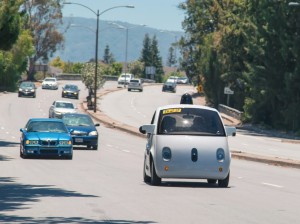
Google said one of its autonomous vehicles was recently involved in the 14th accident, but the first involving injuries.
Sometimes, it seems, there’s nothing that even the smartest cars can do. Yet again, a Google autonomous vehicle was rear-ended, apparently due to a distracted driver. The 14th accident involving one of the self-driving vehicles, it also marked the first involving injuries.
The July 1 crash occurred near the tech giant’s home of Mountain View, California, and saw three employees in the autonomous vehicle go to the hospital due to what’s been described as “minor” whiplash. The driver of the other vehicle also suffered some minor injuries.
“The clear theme is human error and inattention,” Chris Urmson, head of the Google autonomous vehicle program, wrote on his blog. “We’ll take all this as a signal that we’re starting to compare favorably with human drivers.”
Google has been testing autonomous technology for a number of years, initially using modified Toyota and Lexus vehicles, and so far clocking about 1.9 million miles. It is just beginning to roll out the first of what will be 100 specially designed vehicles that will be used around its Silicon Valley headquarters.
The program generated headlines earlier this year when it was revealed that more than a dozen crashes have occurred involving the original test fleet. In all instances, according to Urmson – and backed by crash reports – the other driver has been blamed. With the latest crash, the Google vehicles has been rear-ended in 11 of the 14 incidents.
The latest occurred at a speed estimated at 17 mph. It was enough to knock the front bumper off the other vehicle. Sensors onboard the Google vehicle show that the other car did not brake.
“Our self-driving cars are being hit surprisingly often by other drivers who are distracted and not paying attention to the road,” wrote Urmson. “That’s a big motivator for us.”
In an interview with the Associated Press, Urmson said Google is now considering ways to alert other drivers who may become distracted to help avoid such rear-end collisions.
(Drivers cool to the idea of self-driving cars. For more, Click Here.)
Google isn’t alone. A growing number of automakers have begun using forward collision warning systems, some capable of automatically applying the brakes if the driver fails to respond when a crash becomes likely. The Insurance Institute for Highway Safety reports such technology is already having a significant effect on reducing accidents, and federal regulators are considering the idea of making such systems mandatory.
Forward collision warning is already a key element of autonomous vehicle technology – which many believe will begin to reach production by early in the next decade. Some makers, such as Cadillac, Nissan and Mercedes-Benz, hope to introduce semi-autonomous features to their products as soon as 2016.
(Click Here for more about Ford’s plans for autonomous vehicles.)
While skeptics question how effective the technology will be – and warn of potential problems – proponents insist that the more autonomous and semi-autonomous vehicles there are on the road the fewer accidents will occur.
“Our self-driving cars can pay attention to hundreds of objects at once, 360 degrees in all directions, and they never get tired, irritable or distracted,” wrote Urmson.
(To see more about Audi’s commitment to self-driving technology on the next-gen A8, Click Here.)
Quoting the book, Traffic: Why We Drive the Way We Do, by Sheila Klauer, of the Virginia Tech Transportation Institute, Urmson added, “People, on the other hand, ‘drive as if the world is a television show viewed on TiVo that can be paused in real time – one can duck out for a moment, grab a beer from the fridge, and come back to right where they left off without missing a beat.’”

You have to wonder why Google’s AVs are involved in so many accidents? Concluding that Google’s AVs are doing better than humans is typical hyperbole. AVs can monitor the situation 360 degrees but they still can’t prevent injuries as this example shows.
How many of the accidents may have been avoidable by a competent driver? Probably a number as I avoid ridiculous accident situations almost daily that few if any AV could avoid.
There will be more Google and other AV supplier accidents. Is NHTSA investigating these accidents so there is independent analysis?
The lesson to be taken is with the new corvette. A fantastic car with a bunch of driver assisted systems that make the average driver a far better driver than without them. But for the professional race driver only a few could do better without them than the assisted average driver. The exceptional race driver can outdrive the assisted driver but it becomes much harder to out drive the assisted vehicle in variable weather conditions with out abs and traction control turned on.
That is what allows what was a race car with 600 horse power 30 years ago to be a everyday driver today. Barring insurance rates! Some people should never drive a car! No matter if they can afford them.